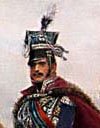 |
| The limits of the French invasion of Russia 1812 |
Every day that passed was allowing the advantage of the strategical situation to move more decidedly in teh Tsar's favor. Kutusov appreciated this and did all in his power to protract Napoleon's stay in Moscow, deliberately playing on his opponent's desire for peace. The Tsar, meantime, subjected to heavy pressure by his advisers, remained intractably aloof. No idea of coming to terms with Napoleon now entered his thoughts. Not only was time playing into the hands of the Russians by bringing "General Winter" ever closer, but it was also permitting the size of their forces to be rapidly augmented. By October 4, the RUssian generals could at last claim numerical superiority on almost every sector of the huge front. South of Moscow, Kutusov's army numbered at least 110,000 men, while Napoleon commanded only 95,000; even if the VIIIth Corps, situated near Borodino, was added to this number, the Emperor could dispose of few more than 100,000 men. On the extended flanks, the overall situation was even more favorable for the Tsar's warriors. On the northern sector, General Wittgenstein (40,000) was facing Oudinot and St. Cyr (17,000) near Polotsk. On the extreme right, General Essen's garrison at Riga (14,000) had recently been supplemented by the arrival of General Steinheil with 10,000 men from the Army of Finland, while Marshal Macdonald was attempting to continue the siege of Riga and at the same time control some 80 miles of teh Dvina down to Dunaburg with only 25,000 men, and of these at least half of the Prussian contingent were of increasingly dubious loyalty. On the southern flank, the army of Admiral Tshitsagov from the Danube had newly combined with Tormassov's Third Army to create a joint force of 65,000 men, more than enough to outfight Schwartzenberg's and Reynier's 34,000. It was true that the 37,000 men of the French IXth Corps in the vicinity of Smolensk were presently unopposed by any regular Russian force, but the increasing number of raids by Cossacks and peasantry against isolated detachments along Napoleon's long lines of communication made its presence there more vital if even a tenuous link with Poland was to be maintained. Similarly, Marshal Augerau was holding some 26,000 conscripts at far-away Stettin and General Loison had a further 10,000 near Koingsberg, but the worsening relations between France and Prussia made it impracticable for these troops to be moved up to the front. The remainder of the starving survivors of the once 600,000 strong Grand Armee were dead, lying in inadequate hospitals, straggling hopelessly over the countryside, or strung out in numerous small detachments along the overextended communications. In other words, Napoleon had shot his bolt, and was left with a huge arrow-shaped salient to defend, extending 360 miles wide at its broadest part and running for no less than 550 miles into the seemingly fathomless depths of Russia to its apex at Moscow. The Russian armies on his flanks were in excellent positions for driving great salients into French-held territory, and might, in due course, isolate Napoleon's main body from its bases. Small wonder, therefore, that the Tsar rebuffed Napoleon's peace feelers and is reputed to have remarked, "This is the moment when my campaign begins."
~ D. Chandler, The Campaigns of Napoleon, p. 817-818















































No comments:
Post a Comment